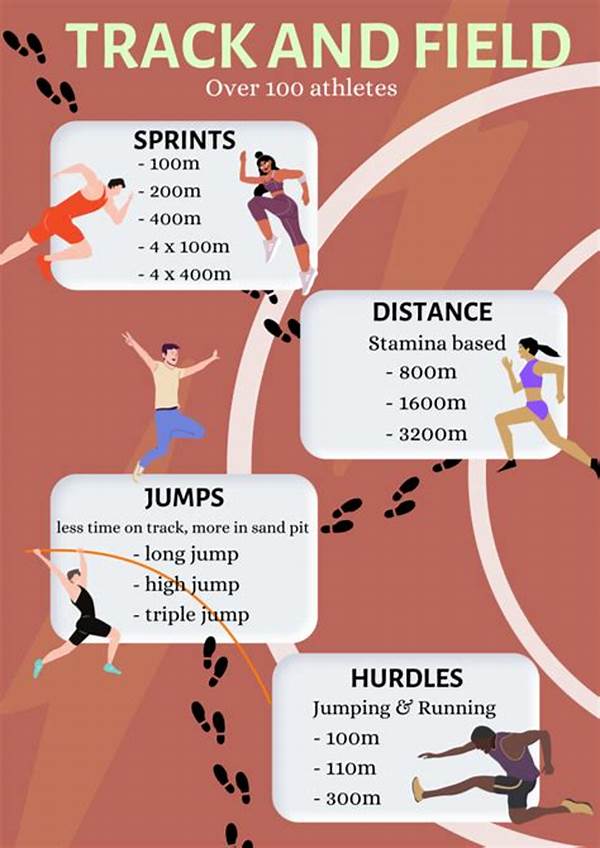Differences Between Track And Field Events In Athletics

- Understanding Track and Field
- Track Events: A Test of Speed and Endurance
- Bridging the Gap: Where Track and Field Meet
- Delving into Specific Events
- Track Events Explained
- The Intersection of Track and Field Events
- The Allure of Athletic Competition
- Field Events: Technique Meets Strength
- Engaging in Athletics
Athletics is a multifaceted discipline that has captured the hearts of millions worldwide. Within this grand sporting arena, track and field events stand out as the core pillars of athletics. However, while often mentioned in the same breath, the differences between track and field events in athletics are both intriguing and vital to understand. Track events are primarily contests of speed, endurance, and sometimes strategy, often taking place on a standard 400-meter oval track. These events include sprints, middle-distance, and long-distance races, as well as hurdles and relays. Athletes focus on time, acceleration, and sustaining speed to outpace their competitors.
Read More : Cultural Importance Of Cricket In South Asia
On the flip side, field events are showcases of power, technique, and precision, taking place in the central area of the stadium. Events such as long jump, high jump, pole vault, shot put, discus, javelin, and hammer throw require athletes to demonstrate exceptional skill and form in jumping or throwing. What these categories share is a rich history and an unparalleled display of human physical achievement, yet their distinctions make them uniquely appealing.
Track events channel raw speed and rigorous training, where victories are often measured in fractions of a second. In contrast, field events engage the audience with the sheer display of technique and the suspense of cleared heights or distances reached. It’s this duality that fuels the excitement of athletics, providing varied spectacles for enthusiasts and casual viewers alike.
From the rhythmic pounding of spikes against the track to the graceful arc of a javelin soaring through the air, the unique characteristics of track and field create a dynamic synergy that showcases the wide spectrum of athletic prowess. This article will walk you through the allure, the nuances, and most importantly, the differences between track and field events in athletics
Understanding Track and Field
Track and field are organized into various events, each with its own set of rules and required skill sets. Track races, including the iconic 100-meter dash, 400-meter sprints, and marathon distances, emphasize speed and stamina. Athletes need to manage fatigue, optimize their running technique, and have a keen sense of pacing. Field events, meanwhile, focus on either horizontal leaps or vertical ascensions—like in long and triple jumps or pole vaults—or on throwing an implement, as in the shot put and javelin throws.
Diving deeper into these differences allows for a greater appreciation of the skills and dedication athletes bring to each discipline. Whether it’s the adrenaline rush of a sprint finish or the silent anticipation before a high jump attempt, the thrill in both track and field events is undeniable. Understanding these differences is crucial for anyone looking to fully appreciate the spectacle and history of athletics, and the incredible feats achieved by these athletes.
—
Athletics as a sport is an expansive field that boasts a variety of events, and the differences between track and field events in athletics serve as an astounding showcase of human capabilities. Track events, defined by their reliance on speed and endurance, contrast sharply against the explosive power and technical finesse prevalent in field events. To a layperson, these differences might seem minimal, but in reality, they demand distinct skill sets and training approaches for the athletes involved.
Track Events: A Test of Speed and Endurance
Track events are categorized into sprints, middle-distance, and long-distance running, along with hurdling and relay races. Each event necessitates unique strategies, from explosive starts in sprints to the strategic pacing of a long-distance marathon. It’s fascinating to note the meticulous training regimens these athletes endure, which combine speed, agility, and mental fortitude to optimize performance.
Field Events: Power and Precision On Display
On the other hand, field events, with their range of jumps and throws, require athletes to harness power, precision, and often sophisticated techniques. Whether it’s launching a javelin with the perfect angle or managing the kinetic energy for a high jump, these feats demand a blend of strength and mastery over one’s body mechanics that is radically different from track events.
An informed spectator, or an aspiring athlete, should consider these elements when observing or participating in athletics. These differences between track and field events in athletics are what create a symphony of competition, where every performance tells a story of dedication and skill.
Bridging the Gap: Where Track and Field Meet
Despite their differences, track and field events are intrinsically linked, harmonizing speed, strength, and skill into a single sporting category. Competitions like the decathlon and heptathlon require athletes to cross the boundaries of specialization, blending track and field skills in a singular display of athleticism that captivates audiences. This crossover emphasizes the holistic nature of athletics, where the boundaries between speed, endurance, and power start to blur.
The culture and history tied to each event create a rich tapestry that has evolved over decades, each discipline contributing to the overarching narrative of athletics. Fans of the sport can gain a deeper appreciation for its cultural and historical significance by understanding these differences between track and field events in athletics.
—
- Attend a live athletics meet to experience the events firsthand.
- Research the individual biomechanics of a chosen track or field event.
- Watch documentaries or interviews with athletes to gain insight into their training regimes.
- Join a local athletics club to receive hands-on experience.
- Explore the history and evolution of track and field events through online resources.
- Engage with online communities or forums dedicated to athletics discussions.
Exploring the differences between track and field events in athletics allows fans and athletes alike to appreciate the sport’s diversity. By engaging in these recommended actions, one can deepen their understanding and connection to these remarkable contests.
Delving into Specific Events
With an interest sparked, diving into specific events can reveal the intricate details that differentiate them. For example, comparing the training for a sprint versus a long jump illustrates the unique demands of each. These sporting events are more than just competitions; they are tales of triumph, struggle, and the relentless pursuit of excellence.
By understanding and recognizing the intrinsic differences between track and field events in athletics, enthusiasts of the sport can enhance their viewing experiences, rooting for their favorite athletes with newfound respect and insight into their varied disciplines.
—
Read More : Sky Sports Offers Exclusive Champions League Coverage This Week
In the world of athletics, the aggregate of skills demonstrated is nothing short of remarkable. The differences between track and field events in athletics are of great interest not only to sports enthusiasts but also to those curious about human capabilities and performance dynamics. While track events focus heavily on speed and the efficient use of time, field events are stalwart exhibitions of strength, technique, and often, endurance.
Track Events Explained
Track events are divided across distances, ranging from sprints like the 100 meters to endurance challenges like the marathon. Each event requires a distinctive set of skills, from a sprinter’s explosive start needing quick-twitch fibers to a marathoner’s energy-efficient stride needing exceptional aerobic capacity. Track athletes often focus on optimizing their start, stride, and finish, with races that rely heavily on tactics and timing.
Field Events: Pure Power and Technique
On the other side, field events invite participants to demonstrate prowess in jumps and throws. The dynamics of these events center around maximizing distance or height. Techniques in, for instance, shot put or high jump are refined further with physics, with athletes repeatedly training to perfect every movement. They often engage in strength training and drills to hone their execution at competitions.
Both categories offer thrilling spectacles, whether it’s the clock-burning exhilarating sprint finishes or the suspenseful moment of a high jumper attempting a record height. For fans of athletics, these differences between track and field events in athletics are what add layers of intrigue and excitement to sports events.
The Intersection of Track and Field Events
Every few years, tracks and fields become battlegrounds where extraordinary human feats are achieved, records are broken, and legends are born. Despite the stark differences, these events together epitomize the collective spirit of athletics, celebrating human potential and endurance.
Understanding the nuances and appreciating the diversity in skills required for track versus field events enhances one’s spectator experience. Whether you’re a die-hard fan or a newbie, the differences between track and field events in athletics offer everyone something unique and exhilarating.
—
- Track events are time-based and concentrate on speed and endurance.
- Field events focus on distance, height, and technique.
- Sprints, relays, and marathons are examples of track events.
- Long jump, shot put, and javelin are common field events.
- Training regimes for track and field events significantly differ.
- Track events primarily use a standard 400-meter oval track.
- Field events are generally performed in the stadium’s center field area.
- Both track and field require mental resilience and physical training.
- Competitions like decathlon combine several track and field events.
- Track and field events together provide a comprehensive view of athletic prowess.
Understanding the differences between track and field events in athletics opens up a world of appreciation for both categories. These insights provide clarity and context to the immense skill and dedication required in each discipline. Whether you’re admiring the raw speed of a 100-meter sprint or the awe-inspiring technique in a pole vault, these differences are part of what makes athletics profoundly fascinating and thrilling to watch.
The Allure of Athletic Competition
Such knowledge encourages spectators to explore more of the athletic world, recognizing the dedication of these athletes in putting exceptional performances that inspire and challenge the human threshold time and again. With these differences clear in mind, viewers can root for athletes with a deeper understanding and appreciation, making every competition an engaging and educational experience.
—
When we think about the glamor and intensity of athletics, track and field events undeniably take center stage. Yet, the differences between track and field events in athletics define the very essence of what makes this sport universally celebrated. Track events push the boundaries of what can be achieved in speed and endurance. From lightning-fast sprints to grueling marathons, the emphasis is laser-focused on time, pace, and strategy.
Field Events: Technique Meets Strength
Meanwhile, field events are the canvas where power meets precision. Athletes take on the challenge of manipulating distances and trajectories, whether it’s a long jump, a shot put throw, or a high pole vault. The techniques they employ are as varied as the events themselves, each requiring a unique combination of physical strength and skillful execution.
The Synergy of Track and Field
Together, these events create a mesmerizing spectacle—each athlete’s discipline offering a different flavor of competition and excitement. The differences allow spectators to appreciate the singular focus and dedication required in both track and field pursuits.
Engaging in Athletics
For someone yearning to delve deep into athletics, exploring these differences can be both enlightening and exhilarating. Whether you’re on the track yourself or speaking from the stands, understanding these nuances can elevate your appreciation and passion for the sport.
In conclusion, the distinct yet complementary nature of track and field events embodies the spirit of athletics, showcasing the extraordinary variety and resilience of human capabilities. Through their differences, they provide a comprehensive arena of athletic excellence, promising endless thrills and moments of awe for all who witness them.



